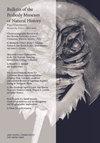Inventory and Assessment of the Pongo (Linnaeus, 1760) Skeletal Collection Housed at the Yale Peabody Museum
IF 0.9
4区 哲学
Q2 BIODIVERSITY CONSERVATION
引用次数: 0
Abstract
Museum collections are critical resources for examination of comparative anatomy, developmental biology, and life history hypotheses. Skeletal collections provide insight into spatiotemporal, species, population, and individual variation associated with environmental, social, and epidemiological history. For endangered species such as great apes, these collections provide data nearly impossible to replicate today. In this third in a series of articles reviewing the great ape holdings of the Yale Peabody Museum, we describe the Pongo skeletal collection. Nine catalog numbers in the collection represent nine individuals: two males, five females, and two individuals of indeterminate sex. Evidence of trauma, socioecology, metabolic stressors, infectious disease, and captive management issues are described in detail. The collection exhibits taxonomic diversity as well, with two species present. Our evaluation of the Yale Peabody Museum collection provides a baseline for future research and testable hypotheses for alternate techniques, such as isotopic analyses of dental calculus and noninvasive genetic testing. Museum collections continue to provide new insights into taxonomic and individual variation and environmental context, ultimately allowing for comparisons between modern and historical environmental and behavioral variables.存放在耶鲁皮博迪博物馆的庞戈(林奈,1760年)骨骼收藏的清单和评估
博物馆藏品是检验比较解剖学、发育生物学和生活史假说的重要资源。骨骼收藏提供了与环境、社会和流行病学历史相关的时空、物种、种群和个体变化的见解。对于类人猿等濒危物种来说,这些收集的数据在今天几乎是不可能复制的。在回顾耶鲁皮博迪博物馆收藏的类人猿系列文章的第三篇中,我们描述了庞戈的骨骼收藏。集合中的九个目录编号代表九个个体:两个男性,五个女性和两个性别不明的个体。详细描述了创伤、社会生态学、代谢应激源、传染病和圈养管理问题的证据。该集合也显示出分类多样性,有两个物种存在。我们对耶鲁皮博迪博物馆藏品的评估为未来的研究和替代技术的可测试假设提供了基线,例如牙结石的同位素分析和非侵入性基因检测。博物馆的藏品继续为分类、个体变异和环境背景提供新的见解,最终允许在现代和历史环境和行为变量之间进行比较。
本文章由计算机程序翻译,如有差异,请以英文原文为准。
求助全文
约1分钟内获得全文
求助全文
来源期刊

Bulletin of the Peabody Museum of Natural History
BIODIVERSITY CONSERVATION-ECOLOGY
CiteScore
2.40
自引率
0.00%
发文量
6
审稿时长
>12 weeks
期刊介绍:
The Bulletin of the Peabody Museum of Natural History publishes original research based on specimens, artifacts and related materials maintained in the collections of the Yale Peabody Museum of Natural History’s curatorial divisions. The Bulletin is published twice a year, in April and October.
 求助内容:
求助内容: 应助结果提醒方式:
应助结果提醒方式:


